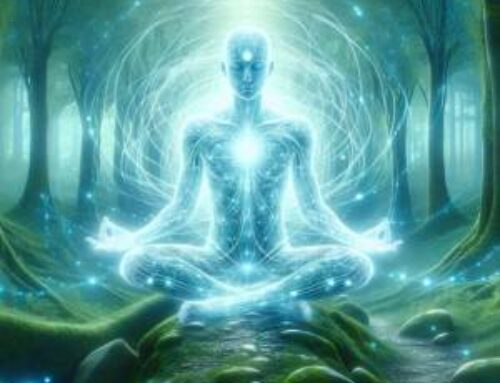Contents
- 1 Introduction to Meditation God’s Presence
- 2 Techniques and Preparations for Meditation: Harnessing Traditional Wisdom for Divine Connection
- 3 Experiential Realizations through Meditation: Discovering the Divine Within
- 4 Transformation Through Meditation in Spiritual Traditions: A Journey of Enlightenment
- 5 Meditation as a Path to Spiritual Enlightenment: Unlocking Higher Consciousness
- 6 Conclusion
- 7 FAQ – Meditation God’s Presence
- 7.1 1. What is the primary goal of practicing meditation to experience God’s presence?
- 7.2 2. How can beginners prepare to meditate effectively to feel God’s presence?
- 7.3 3. Can meditation lead to lasting changes in how I perceive the world?
- 7.4 4. What is the ‘Merkabah,’ and how is it related to meditation?
- 7.5 5. Where can I learn more about integrating meditation into my daily life to enhance God’s presence?
- 8 References
Introduction to Meditation God’s Presence
In the serene realms of contemplation, where silence speaks volumes, meditation emerges as a profound practice to experience God’s presence. This revered art, embedded in spiritual traditions, is not just a relaxation method but a deep dive into the soul’s communion with the divine. Through meditation, seekers are invited to transcend the transient noise of daily life, stepping into a realm where the divine presence offers profound peace and spiritual awakening. Exploring Meditation God’s Presence helps uncover the deep layers of spiritual awareness hidden within us.

Drawing on ancient wisdom, this exploration will guide us through sacred techniques that allow for a deeper connection with the divine. These teachings illuminate the path toward not only encountering God’s presence but integrating this profound experience into our daily lives, transforming our very essence.
Techniques and Preparations for Meditation: Harnessing Traditional Wisdom for Divine Connection
Establishing the Physical Foundation
Through Meditation God’s Presence, practitioners often report experiencing a tangible sense of peace and spiritual clarity. One of the essential steps in preparing for effective meditation is the physical setup, which involves adopting a comfortable yet deliberate posture that supports prolonged periods of stillness. Traditional teachings recommend sitting with a straight spine — often referred to as the Pharaoh’s Seat — which is a posture reminiscent of the statues from ancient Egypt. This position helps maintain alertness and facilitates the flow of spiritual energy without the distraction of physical discomfort.
Focusing the Mind through Breath
Breath control is another foundational practice in meditation that is deeply rooted in traditional teachings. Before delving into deeper meditative states, it is beneficial to engage in controlled breathing — taking rhythmic, deep breaths from the abdomen. This technique not only prepares the body but also calms the mind, making it receptive to the spiritual experiences that meditation offers.
Engaging in Silent Contemplation
Once the physical and initial mental states are set, the practice of silent meditation begins. This involves the inward focus on silence itself, perceiving reality without attachment to personal identity or ongoing mental narratives. Traditional practices describe this state as an uninterrupted flow of divine information, where the meditator becomes one with the object of meditation, achieving a profound connection with the divine essence.
Experiential Realizations through Meditation: Discovering the Divine Within
The Threshold of Divine Encounter
Spiritual practice reenchants the everyday by reappropriating and articulating the world through embodied practices, resulting in spiritual enlightenment through a reinhabited appropriation of the world (1).
Meditation is more than a practice of quieting the mind; it is the key to unlocking a direct encounter with the divine. This profound connection offers tangible experiences of God’s presence, providing a certainty about the divine that is as real as our own existence. Through the silence and depth of meditation, a sacred space opens within consciousness, where we recognize God not as a distant figure but as a living presence both within and around us.
The Vision of Merkabah
One of the most mystical experiences in meditation is the vision of the Merkabah, or “chariot” in Hebrew. This symbolizes a state where the meditator ascends into the divine realms, experiencing supernatural encounters. The practice and understanding of this vision are considered esoteric, taught only to those who are deemed ready and worthy. It represents a transformative journey that elevates the practitioner’s spiritual state, offering a profound connection and union with the divine.
Spiritual Transformation and Enlightenment
Enlightenment and spiritual growth are continuous, multidimensional processes, involving various available states of consciousness and the skill in effectively using them in various situations (2).
The journey through meditation leads to an expansion of consciousness, where the meditator experiences unity with the universal consciousness that encompasses and penetrates all things. This stage is the culmination of the meditation process, where individual identity merges with the divine, transcending the self and realizing a state of oneness. This is not just a philosophical concept but a lived experience that fundamentally changes the practitioner’s view of reality and their interaction with the world.
Transformation Through Meditation in Spiritual Traditions: A Journey of Enlightenment
The Inner Experience of the Divine
Meditation serves as a profound gateway to not just a theoretical understanding of God but an experiential encounter that brings certainty and tangibility to the divine presence. This encounter is described as opening a space of consciousness where God is perceived not as a remote entity, but as an intimate presence permeating one’s being and the universe. Meditation God’s Presence is not just a practice but a gateway to experiencing life in its fullest spiritual dimensions.
The Path of the Merkabah
Within these teachings, the practice of the Merkabah, or divine chariot, emerges as a pivotal meditative vision, guiding the practitioner through supernatural chambers to the very essence of God. This esoteric practice is considered sacred and reserved for those who have been deemed ready to receive such profound wisdom, thus transforming their spiritual understanding and perception.
The Threefold Path of Meditation
Meditation in these spiritual traditions unfolds in three phases: relaxation, internalization, and expansion of consciousness. The journey begins with achieving a relaxed state, progresses through a phase where the mind is focused and stilled by concentrating on sacred symbols or breath, and culminates in the expansion of consciousness. This final stage leads to a profound unity with the universal consciousness, where the individual’s sense of self transcends to encompass a larger, divine reality.
Realization of the Divine Within
The ultimate goal of this transformative meditation is the realization that the Kingdom of God is within, waiting to be discovered and manifested. This internal discovery aligns with the mystical understanding that all external quests for divinity are reflections of an internal journey toward recognizing the divine essence already present within the self.
Spiritual journeying is a lifelong process that involves exploring one’s inner self and a larger cosmic consciousness, often leading to transformational experiences and assisting others in healing processes (3).
The expanding of consciousness in meditation transcends mere intellectual understanding; it is a realm of silence. This profound state moves beyond the ego or the ‘I’, reaching into a connection with the higher self. In this space, one perceives a higher consciousness, free from the identifications with the lower personality — aspects like intellect, emotions, and behavior patterns — and transcends physical body constraints. This experience ushers in a direct and unmediated communion with the divine, revealing deeper truths of existence and unity (4).
Meditation as a Path to Spiritual Enlightenment: Unlocking Higher Consciousness
Meditation transcends ordinary experiences of awareness by providing a pathway to profound spiritual enlightenment. This transformative journey is rooted deeply in the practice of connecting the inner self with universal consciousness, fostering a union that enlightens and enriches one’s understanding of both the self and the cosmos.
Direct Encounter with the Divine
Through meditation, practitioners achieve more than just mental clarity or emotional calmness; they experience a direct and tangible connection with the divine. This is not merely about achieving a relaxed state but about realizing an unshakable certainty of God’s presence, as real and undeniable as one’s own existence. In these moments, the meditator accesses a sacred space where God is recognized as a living presence, both within and around.
Vision of Merkabah and Spiritual Ascension
The journey includes experiences such as the vision of the Merkabah, symbolizing the chariot to the divine. This ancient mystic practice illustrates a meditator’s ascension into the supernatural realms, achieving a state of enlightenment where the seer unites with the divine essence. This part of meditation is seen as a pivotal transformation, elevating the practitioner’s spiritual state through profound connections.
Conclusion
As we conclude our exploration of “Meditation God’s Presence,” we recognize meditation as more than a practice—it is a profound pathway to spiritual enlightenment. The techniques for Meditation God’s Presence are designed to foster a profound connection between the meditator and the divine essence. This journey, rich with ancient wisdom and transformative experiences, offers each practitioner an intimate encounter with the divine. Through the silence and depth of meditation, we not only encounter the divine presence but begin to integrate this profound awareness into every aspect of our lives. Regular practice of Meditation God’s Presence can transform our daily experiences, imbuing them with a sense of the divine.
Experience the Most Powerful Meditation Techniques for Enlightenment
To deepen your understanding and practice of meditation, we invite you to join the Hermetic Academy. Here, you can explore further the sacred techniques and spiritual teachings that enhance connection with the divine. The Hermetic Academy offers courses, resources, and a supportive community that guides you on your journey toward spiritual enlightenment.
FAQ – Meditation God’s Presence
1. What is the primary goal of practicing meditation to experience God’s presence?
A: The primary goal is to transcend everyday consciousness and enter a state where one can directly experience and commune with the divine. This form of meditation deepens one’s spiritual connection and enhances self-awareness by aligning with the divine essence that permeates all existence.
2. How can beginners prepare to meditate effectively to feel God’s presence?
A: Beginners should focus on establishing a quiet, dedicated space for meditation and adopting a comfortable posture that promotes stillness and alertness. Techniques such as controlled, deep abdominal breathing are essential for calming the mind and preparing the spirit for deeper spiritual encounters.
3. Can meditation lead to lasting changes in how I perceive the world?
A: Yes, regular meditation focused on experiencing God’s presence can transform your perception of the world. It expands your consciousness beyond the self, allowing you to experience a profound unity with all of existence, which can change how you interact with the world and perceive everyday realities.
A: The Merkabah, or “chariot” in Hebrew, refers to an advanced mystical vision experienced during deep meditation. It symbolizes the journey and ascension into the divine realms, offering the meditator profound insights and a closer union with the divine essence.
5. Where can I learn more about integrating meditation into my daily life to enhance God’s presence?
A: To explore more about integrating meditation into your daily practice and enhancing your spiritual journey, consider joining the Hermetic Academy. The Academy offers initiations, extensive resources and guidance on deepening your connection with the divine through meditation.
References
(1) Holloway, J. (2003). Make-Believe: Spiritual Practice, Embodiment, and Sacred Space. Environment and Planning A, 35, 1961 – 1974. https://doi.org/10.1068/a3586.
(2) Tart, C. (2003). ENLIGHTENMENT AND SPIRITUAL GROWTH: Reflections from the Bottom Up. Subtle Energies & Energy Medicine Journal Archives, 14.
(3) Keegan, L. (1991). Spiritual Journeying. Journal of Holistic Nursing, 9, 14 – 3. https://doi.org/10.1177/089801019100900103.
(4) Rubenstein, E. (2024) The Hermetic Experience: From Mystery to Self-Knowledge. Hermetic World, Paphos.





